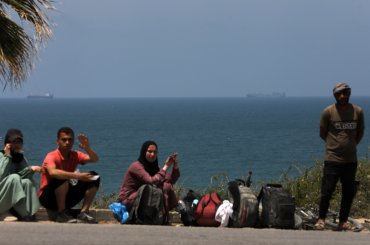Jeff Blankfort responds to the Times review of Waltz with Bashir:
I read the explanation by the filmmaker
Ari Folman as to why he focused on the Israeli side. It is typical of the way Israelis and their supporters have used the
massacre at Sabra and Shatila to mask the far greater war crimes
committed by Israel
in launching that war. I am sure that there is nothing in the film that
mentions that, aside from that massacre, the Israelis killed an
estimated (by the Red Cross) of 17,000 civilians, and wounded tens of
thousands more by their indiscriminate use of American cluster bombs
and white phosphorus against the Lebanese and Palestinian civilian
population.
I also suspect there is no mention of the fact that the
Israeli tank corps blew a hole in the side of every building along the
highway from the Israeli border to Beirut, something an Israeli tank corps lieutenant, who later became a member of the Yesh G'vul refusenik group, told me in Jerusalem before I went into Lebanon
and who I thought had been exaggerating until I traversed that route by
taxi. "You Americans give us all the bullets and shells we want," I
remember him telling me, shaking his head. Here's Ethan Bronner:
"Some
Arab critics have complained that Mr. Folman emphasizes the impact on
Israelis rather than on those who truly suffered: the Palestinian
refugees and the Lebanese. But Mr. Folman said he wanted to explore the
issue from a personal and Israeli perspective. To do otherwise would be
patronizing. âI feel very strongly that it is not my mission or job to
deal with the other side,â he said".
The war on Lebanon
was considered by Israel to be a "war of choice" and some 2000
reservists joined Yesh G'vul (which has a double-meaning in Hebrew:
"there is a border" and "there is a limit") and chose not to
participate and some went to prison. I wonder if that was mentioned in
the film? That war, if one can call it that, gave birth to the concept
of "shoot and cry," where the poor Israelis who were forced to kill
anyone who stood in their way, would cry afterward, and their fellow
Israelis would give the killers a hug.
From my experiences with
the Israeli military in Lebanon a year later, in which one of them
fired a shot that creased my hair while I was taking a photo, I have
little sympathy for what "suffering" they experienced in a country
without an army where the resistance came only from ragtag militias. It
wasn't, in fact, until Hezbollah arose in 1983 in response to the
racist nature of Israel's occupation that the Israelis started taking
significant casuallties. What isn't generally known is that the
majority of the Shia population in the south welcomed the Israelis in
hope that they would clear the PLO out of the area and let them live
their lives in peace. But to the Israelis, one Arab was like any other
so they proceeded to treat the Lebanese exactly as they do the
Palestinians.
The
Western non-American press corps, unlike its US counterpart, saw the
Israelis for the bullying brutes they were and most cheered when
Hezbollah blew up Israel's intelligence HQ in Sour/Tyre. That led the
Israelis to impose collective punishment on all of southern Lebanon, refusing to allow food or other
supplies to cross the Alawi bridge that separates the north from the
south for days. It was standing near the bridge in front of miles of
stalled cars and trucks, with an Israeli tank only a dozen yards away
that I felt the crease on my hair from the Israeli's shot. I changed my
lens, took one more picture of two Israeli soldiers headed my way with
their M-16s, one of whom had fired on me, and then turned around and
walked back behind a roll of barbed wire that blocked the highway.

